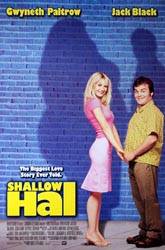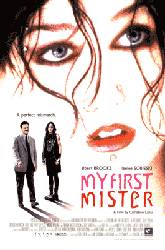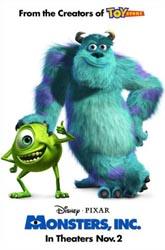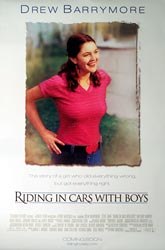 |
Shallow Hal
(Dir: Peter and Bobby Farrelly, Starring Jack Black, Gwyneth Paltrow, Jason Alexander, Joe Viterelli, Susan Ward, Anthony Robbins, Kyle Gass, Laura Kightlinger, Sascha Knopf, and Libby Langdon) BY: DAVID PERRY |
| Cinema-Scene.com > Volume 3 > Number 44 |
Cinema-Scene.com
Volume 3, Number 44
This Week's Reviews: Shallow Hal, My First Mister, Monsters, Inc., Riding in Cars with Boys.
This Week's Omissions: Domestic Disturbance, Happy Accidents, The One, Tortilla Soup.
Capsule Reviews: Max Keeble's Big Move, Soul Survivors.
 |
Shallow Hal
(Dir: Peter and Bobby Farrelly, Starring Jack Black, Gwyneth Paltrow, Jason Alexander, Joe Viterelli, Susan Ward, Anthony Robbins, Kyle Gass, Laura Kightlinger, Sascha Knopf, and Libby Langdon) BY: DAVID PERRY |
Three years have passed since Peter and Bobby Farrelly proved themselves as deft comedy directors with There's Something About Mary. That film looked like an oddity of pure luck after the Farrelly's proceeded to make a string of mistakes like Outside Providence (which they did not direct, but wrote and produced), Say It Isn't So, and Osmosis Jones. I thought the fine comedic directors, who learned as filmmakers through Dumb and Dumber and Kingpin and graduated with There's Something About Mary, were lost for good. Those three late mistakes, I suppose, were the creations of an interim drop-out: Shallow Hal, their latest, would be the fine college-bred creation of their oeuvre. Little did I ever think college-bred would refer to a Farrelly Brother's film.
Shallow Hal is smart and sweet, assets that were present in There's Something About Mary but were missed in everything before and since. The directors, known best for their gross-out humor, choose to tone down this film and create only one sequence at a level akin to the zipper in Mary and the cow's milk in Kingpin. Almost all of the Farrelly characters before now have suffered from some stupidity running their lives -- whether it be complete incompetence or temporary ineptitude in the face of love -- and have not seemed real. Shallow Hal, with its winners and losers, comes off like something that might be made of real people. There are characters at the same mindset running around this world like those North Carolinians the Farrelly Brothers capture.
The events, as one would expect for the directors, are not quite as real as the characters are, a closer fit to Herzog than Fassbinder. The movie is about a so-called ladies man who only settles for women far out of his league. The man is Hal, stuck in the short and pudgy body of Jack Black. He has a good, outgoing personality that quickly brings the affection of some good looking women, but everyone sooner or later notices just how shallow he is. That is, everyone but Hal.
When stuck in an elevator with self-help guru Anthony Robbins, Hal admits to all his feelings towards women. Robbins uses one of his more mystical techniques on Hal to de-hypnotize him (according to Robbins, Hall has been hypnotized by popular culture into believing that only physically beautiful women are worthy of being with): from hereon out Hal's eyes will only see the inner beauty of people for their physical figures. In other words, when he meets an ugly girl with a great personality in a cab after the elevator stop, Hal believes that he has just met and wooed a model.
Soon Hal becomes fixated on a 300-pound woman named Rosemary, who looks like Gwyneth Paltrow to him. Since she is so large, his best friend Mauricio (Alexander) thinks he is in a dating rut, and since she happens to be the daughter of Hal's boss, his coworkers (including Tenacious D's Kyle Gass and Saturday Night Live's Laura Kightlinger) think he is trying to sleep his way up the latter. Hal, all the while, believes he has found the perfect woman: not only is she beautiful, but also a great person.
The key to Shallow Hal's success is that Jack Black makes the role his own and delivers a performance that could not have worked in the hands of another actor. He looks like someone who would be so superficial and his demeanor makes the joke all the more funny. He was previously seen with great regard in Jesus' Son and High Fidelity and stole all of his scenes. Those roles are nothing like what he gives us with Hal -- Jack Black has proven that he is more than just a one-joke comedian.
Black and Paltrow show a great deal of chemistry, an odd surprise considering the two performers. The way Black gives sincere compliment and Paltrow's aghast reactions deliver the film a fine quantity of laughs (for example, Hal often dotes on just how thin and perfect Rosemary is, which she takes as sarcastic ridiculing of her figure). Thanks to skillful directing by the Farrelly's in showing both a thin and heavy Rosemary, the relationship comes off as something pathetically beautiful: in a way the audience feels bad that Rosemary must deal with someone like Hal, but happy that he is there for her.
It is this gentle kindness in Shallow Hal that
marks it as the most defined and notable film from Peter and Bobby Farrelly. There's
Something About Mary was a sweet romantic comedy with huge servings of crude humor --
Shallow Hal instead tries these conditions without the toilet humor and goes
beyond its predecessor. As a comedy, Shallow Hal may not be as funny as There's
Something About Mary, but as a romantic comedy, it goes beyond the Mary
levels.

| BUY THIS FILM'S FROM AMAZON.COM |
REVIEWS OF THIS FILM |
 |
My First Mister (Dir: Christine Lahti, Starring Leelee Sobieski, Albert Brooks, Desmond Harrington, Mary Kay Place, Carol Kane, Michael McKean, John Goodman, Henry Brown, Gary Bullock, and Lisa Jane Persky) BY: DAVID PERRY |
Christine Lahti's debut as a feature film director with My First Mister bares little resemblance to her Oscar winning short film Lieberman in Love. That film was brooding but demanding and in 39 minutes held more heart than the entire 108-minute length of My First Mister. It is tough to chastise the director for making something as woefully forgettable as this film because her love for the project seems so strong.
The actress has long been proven as one of the finer actresses subsiding on television playing roles of fine grace and extremely likable qualities. Her direction does seem akin to this style of acting, which does not turn out to be an attribute for the film's narrative structure. Corny character framings and pseudo-stylized shots give the film a garish quality not seen since Frank Whaley went behind the camera for Joe the King.
The film is about the friendship that arises between two lonely souls. The younger of the two is 17-year-old Jennifer (Sobieski), a masochistic Goth with piercings and tattoos to spare; the older is 49-year-old Randall (Brooks), a conservative men's clothing store owner with little interest in anything outside of normalcy. The key is that Jennifer is neither conservative nor normal and their relationship seems like something out of Harold and Maude.
But, despite what the story seems to lead to, that the sexual attraction is muted. Though Jennifer, or J as she prefers to be called, makes it clear to Randall that she is willing to enter a conjugal relationship with him, he scoffs at it. She has been able to get him into a beach shirt and into a shady bar, but that hurdle he's not ready to cross.
This covers the film's first two acts (which are so alike that they verge on redundancy) but what happens in the third act serves as why My First Mister ultimately fails. A few more characters are introduced and a maudlin story arch comes into play making the film into a mess of third act digression. The preceding two acts were not great, but they are definitely much better than the third.
The critical consensus following the opening night screening of My First Mister at the 2001 Sundance Film Festival was that the film was a fine creation up until this final act. I disagree -- while the previous 70 minutes or so of the film had been watchable, they were far from great. In fact, that third act mishap only continues the downward spiral the film is pained by from the beginning.
Jeffrey Jur, who has been on a role this year, delivers some fine imagery in the film when he is not shooting some of Lahti's more disagreeable ideas. The cinematographer will definitely not come out with an Academy Award nomination this year, but he has turned out to be the Edward Lachman of 2001.
The only thing in My First Mister that is absolutely without flaw is the acting. Leelee Sobieski goes against type for a role that would have nothing to say to some of the young girls she's brought to the screen in The Glass House, Joy Ride, Eyes Wide Shut, and A Soldier's Daughter Never Cries. Her choice to play the role is exemplary for young ingénues in Hollywood, though her career choices in the past have always been noticeable for the better characters she's taken.
Albert Brooks, though, is the key to the film. His comedic style works perfectly with the more dramatic moments in the film. He proved this before in various neo-Woody Allen roles, but here he does it without the normal underlying neurosis. He brings the character to life and allows the audience to become more involved with the often clichéd character than most actors would have allowed. Brooks' work in the film could be his best in the dramatic field.
My First Mister is hurt a great deal by following Ghost
World in release. The movie would have been lackluster anyway, but now it feels late
to the game. The Terry Zwigoff film worked with the May-December relationship with charm
and dark humor. Christine Lahti's film, however, loses the charm and the humor only to end
sourly.

| BUY THIS FILM'S FROM AMAZON.COM |
REVIEWS OF THIS FILM |
 |
Monsters, Inc. (Dir: Pete Docter, Voices include John Goodman, Billy Crystal, Steve Buscemi, Mary Gibbs, James Coburn, Jennifer Tilly, Bonnie Hunt, Frank Oz, Bob Peterson, John Ratzenberger, Jeff Pidgeon, Daniel R. Gerson, and Sam Black) BY: DAVID PERRY |
Monstropolis is a huge city situated in a parallel world, where monsters live lives much like their human counterparts. They eat, live, and work in locations like anyone walking through midtown Manhattan, and yet the details are different. They eat bile and other odd fruits, live in places filled with references to monstrous aspects, and work in factories that use human screams for electrical energy to run the city.
That is the summary to the setting of Monsters, Inc., a film about the monsters that live in the closets of small children. We probably all remember them -- they are part of that overworked imagination found in nearly every young mind -- and can only envision a film intent on these creatures.
But today's children, desensitized by violent material on television, are not quite as susceptible to the monster scares as they once were. Since the entire city of Monstropolis' energy is dependent on the bottling of the screams, this means an energy crisis. The mayor warns all the denizens of rolling blackouts and the newspapers continue to wonder the future of the city's energy (there's a Grey Davis joke somewhere in this, but I'll digress).
The factory in charge of creating and bottling these screams is Monsters, Inc., where scary monsters and their technicians come in for particular time zones and enter the rooms of their assigned kids. Like any factory, they have crosscutting lines, quotas, and emergency protocols. One particular emergency is human contamination for the monsters: according to urban legend, a human touch to a monster means instant death.
Two of the scaring monsters are meeting their quotas and, when the film introduces them, they are intent on a battle over bottling the most. The leader at this point is James P. Sullivan (voiced by Goodman), a purple and green monster with horns and a frightening demeanor. His main competitor is Randall Boggs (Buscemi), a reptilian green monster with chameleon-like qualities who is willing to do almost anything to win the competition.
Sullivan and his best friend/roommate/technician Mike Wazowski (Crystal) have a great deal of trouble on their hands when Sullivan accidentally lets a little girl into Monstropolis as he discovers Randall trying to cheat in the competition. If they are caught with this baby, whom Sullivan affectionately calls Boo (Gibbs), they will be banished since they have been in contact with a human for so long. Mike wants desperately to get rid of the kid to save his neck, but Sullivan slowly finds himself drawn to the cute tyke.
Monsters, Inc. serves as the fourth film from Disney/Pixar and stands on shoulders previously responsible for both Toy Story films. Though the director of those two (as well as Pixar's slightly overrated A Bug's Life -- give me Antz any day), John Lasseter, is only executive producing this time, the main writers, Dan Gerson and Andrew Stanton are along to keep the proceedings close to Pixar's previous works.
The film does not meet the high bar set by Toy Story and its superior sequel, but it does try hard to come close and director Peter Docter succeeds. The film is a little more saccharine than previous outings (think of thirty minutes of sentiment comparable to the "I Will Go Sailing" sequence from Toy Story and the "When Somebody Loved Me" sequence from Toy Story 2) but the sentimentality works for the most part. Normally I'd run screaming from a film that uses a cute kid for a character (like, say, Riding in Cars with Boys), but Boo in Monsters, Inc. proves that cute kids are not necessarily always cloying.
The rapport between the two lead vocal artists is remarkable. Unlike the usual single person to a studio setup, Crystal and Goodman performed their scenes in a studio together, always working off of each other. The deep bass to Goodman's voice gives a soothing aural side to a giant visual body and a perfect balance to Crystal's Jersey neurotic. James Coburn (as the Boss Tweed-like owner of Monsters, Inc.), Jennifer Tilly, and Steve Buscemi all do great work with their roles as well.
The nearly blemish free design to the animation stands at the same high echelon of Pixar's previous works (a single shot of hair blowing in a blizzard wind has to be one of the finest visuals in animated history). The men and women at Pixar, whose work was made clear in the beautiful Ultimate Toy Box DVD set, have gone all out in creating creatures so hideously engaging, especially the body of Mike who is just arms, legs, horns, a mouth, and a huge eyeball.
Earlier this year I marveled at the images found in Final
Fantasy: The Spirits Within while never really getting the impression that the
filmmakers were interested in having a great story to go with their great visuals. That is
not the case with Monsters, Inc. -- Pixar gives credence to the belief that they
are the premier computer animators, not only because they make fine productions for the
eyes, but also because they make their films about so much more.

| BUY THIS FILM'S FROM AMAZON.COM |
REVIEWS OF THIS FILM |
 |
Riding in Cars with Boys (Dir: Penny Marshall, Starring Drew Barrymore, Steve Zahn, Adam Garcia, Brittany Murphy, James Woods, Lorraine Bracco, Cody Arens, Logan Arens, Logan Lerman, Mika Boorem, Peter Facinelli, David Moscow, Desmond Harrington, Maggie Gyllenhaal, Sara Gilbert, Marisa Ryan, Vincent Pastore, and Skye McCole Bartusiak) BY: DAVID PERRY |
It takes over two hours for the title of Riding in Cars with Boys to make sense, and by the time it doesn't matter: the film has failed to deliver much to speak of. Yes, there are repercussions to parking in cars with boys, but the riding bears something different and, in a way, the only real rewarding aspect to the entire film.
The film (and its title) come from a memoir written by Beverly D'Onofrio, whose tough life probably made for an interesting read, though its cinematic realization bears few fruits. But that's enough complaining since Riding in Cars with Boys turns out better than some of the saccharine filled dramedies that usually come out of the woodworks.
The film follows Beverly from 15 to 36 and jumps between throughout. When the film begins in 1986, she is getting ready for a trip with her son Jason (Garcia). He is now 20 and contemplating a change in college and a long-budding relationship, she is now a novelist looking to get approval from her estranged ex-husband to publish a book about her life with him.
All through the trip Jason remembers the life her mother had after a surprise pregnancy at 15. She was the daughter of a somewhat stern Connecticut police commissioner (Woods) who fears any early aging by his daughter (as is seen in the film's earliest moments when an adolescent Beverly requests a bra for Christmas). When a failed attempt to court the attention of a popular jock at a party she was not invited to, Beverly falls to the side of criminal deviant Ray Hasek (Zahn). That night Beverly and Ray, along with their friends Fay (Murphy) and Lizard (Moscow), park their car outside the party and consummate their relationship. Beverly soon learns she is pregnant.
Pushed by her parents, Beverly decides to marry Ray, though the joining seems as ill fated as possible. And, nine months later, baby Jason is born. All the while, she can hear her dreams of going to NYU and becoming a novelist flush down the toilet. With a kid and an untrustworthy spouse, Beverly has all the problems she can imagine for the time being.
As Riding in Cars with Boys progresses it loses its steam, which makes it hard to watch late into the film considering that it was not steaming along too well from the beginning. Beverly D'Onofrio's life seems interesting, but the flaccid narrative structure to the movie makes it teeter along aimlessly at times. Some of the film's comedic moments work, but a great deal of the dramatic scenes fall flat as neither the screenplay by Morgan Ward nor the direction by Penny Marshall really knows where to go.
One of the few parts of Riding in Cars with Boys that really works is the actors. Drew Barrymore comes out of the film with a great deal of spirit and virtue, even though the character does some of unlikable things (as the ultimate sadomasochist mother, Beverly continuously falls to horrible circumstance always turning the blame to her son). Holding up the support, Steve Zahn takes the time to show there's a fine dramatic actor in his dim-witting oeuvre. The strongest asset, though I'm sure he'll fail to get any notice, is James Woods who gives a performance akin to Mr. Lisbon in The Virgin Suicides. His tough lover is one of the best characters from the actor in these years since Nixon.
Penny Marshall is not really that bad a director, just one
with little to speak of. She has directed two great films, Big and Awakenings,
and most of her other films are good in their own way. However, she gets a reputation for
horrible films by being Garry Marshall's sibling. Riding in Cars with Boys never
really asks much of the actress-turned-director, and her laissez-faire filming seems
somewhat refreshing considering the material. If this had been more stylized than the
story might have fallen to the wayside -- as it is, the direction is perfectly pedestrian.
Hey, just like the film.

| BUY THIS FILM'S FROM AMAZON.COM |
REVIEWS OF THIS FILM |
Capsule Reviews: Since things are backlogged and there happens to be two spots in this week's lineup, I have decided to use capsule reviews for Max Keeble's Big Move and Soul Survivors (plus, they were not viewed in a theatre). Though, as I said in the last capsule review column, these would be better suited if they were called "Flippant Remarks."
| Max Keeble's Big Move (Dir: Tim Hill, Starring Alex D. Linz, Larry Miller, Zena Grey, Josh Peck, Jamie Kennedy, Nora Dunn, Robert Carradine, Amy Hill, Brooke Anne Smith, Clifton Davis, Noel Fisher, Orlando Brown, Amber Valletta, Justin Berfield, and Veronica Alicino) BY: DAVID PERRY Completely harmless family film that feels like a rejected
Nickelodeon television series, Max Keeble's Big Move fails only because it never
goes anywhere. Linz and Miller try their best and sometimes come out beyond their lifeless
material. Shame on Jamie Kennedy for taking such an odious role. |
Soul Survivors (Dir: Stephen Carpenter, Starring Melissa Sagemiller, Wes Bentley, Casey Affleck, Eliza Dushku, Angela Featherstone, Luke Wilson, Allen Hamilton, Barbara Robertson, Richard Pickren, and Rick Snyder) BY: DAVID PERRY Attempting to waste the talents of Luke Wilson, Wes
Bentley, and even Eliza Dushku, Soul Survivors proves to be little more than a
scareless horror film whose intentions were probably of higher value than the end product.
Digressions leading to Nietzsche and Freud bare little resembling the genius of the two
masters and only a fine Wes Bentley performance proves anything worthwhile in this clunker. |
| BUY THIS FILM'S FROM AMAZON.COM |
BUY THIS FILM'S FROM AMAZON.COM |
Reviews by:
David Perry
©2001, Cinema-Scene.com
http://www.cinema-scene.com